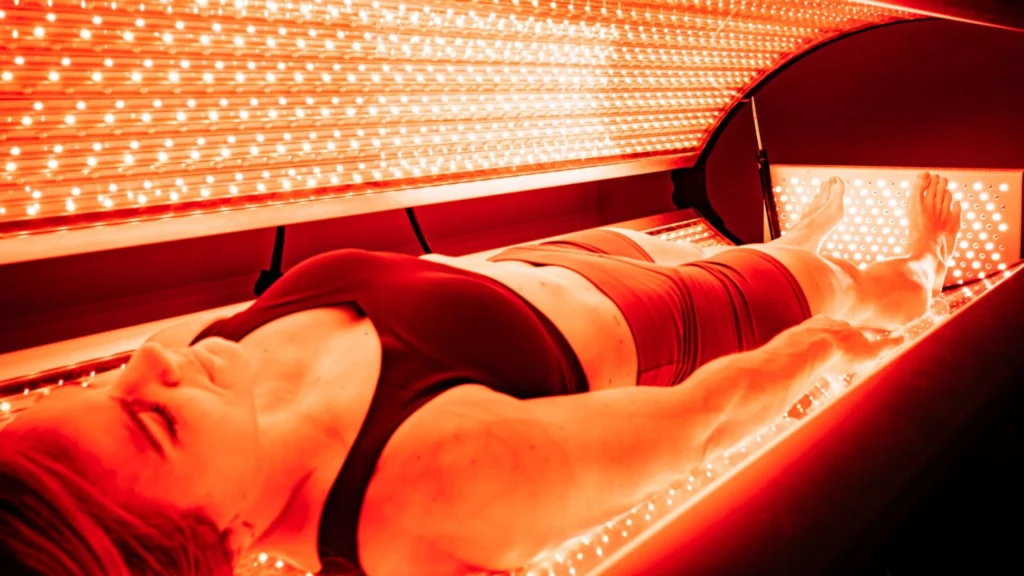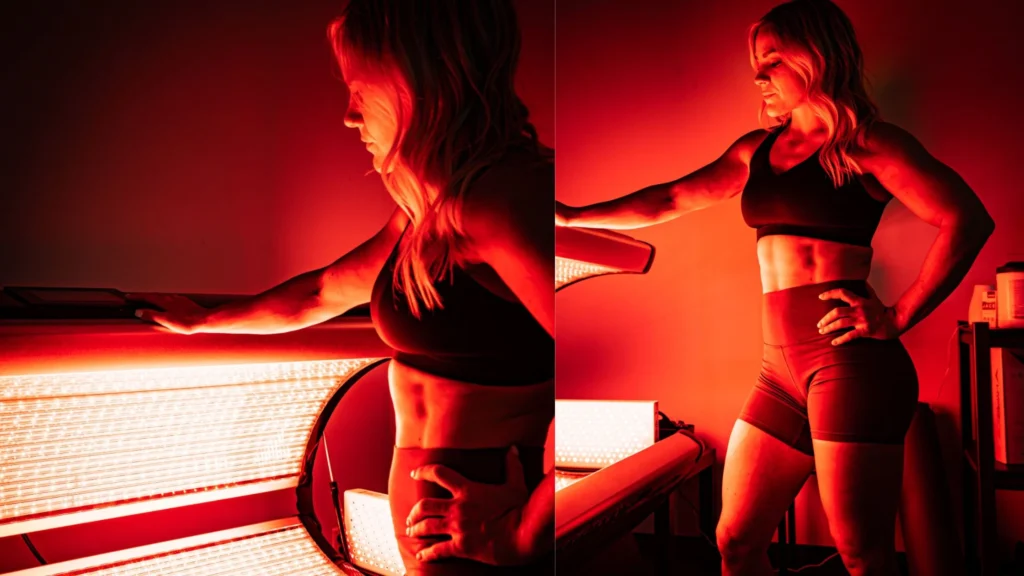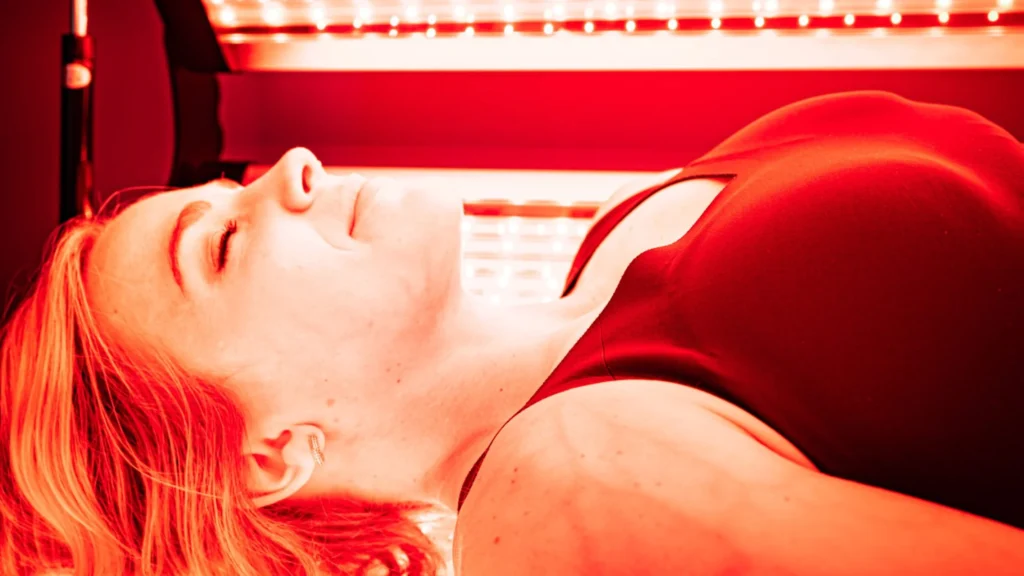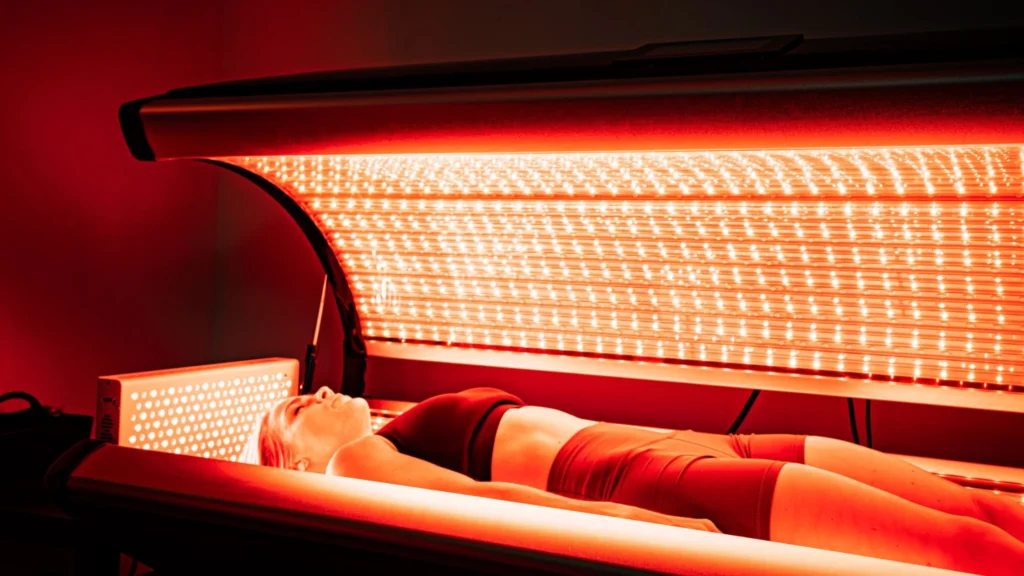Red light therapy has rapidly gained recognition as a non-invasive treatment modality that leverages specific light wavelengths to promote healing and enhance overall wellness. In fact, many practitioners consider it a way to fuel health & wellness by improving skin health and reducing inflammation. Scientific advances in photobiomodulation have illuminated the mechanisms by which red light interacts with cells, supports pain relief, improves skin health, reduces inflammation, and even benefits cognitive and mood parameters. This article explores the scientific foundations behind red light therapy, provides evidence-based insights into its therapeutic benefits, and discusses practical applications alongside safety considerations.
Red light therapy employs low-level wavelengths—typically between 600 nm and 700 nm—to stimulate cellular processes. When exposed to red light, cells absorb photons via chromophores (such as cytochrome c oxidase) in the mitochondria, the energy centers of the cell. This absorption enhances adenosine triphosphate (ATP) production, ultimately accelerating tissue repair, reducing oxidative stress, and modulating inflammatory responses. Researchers have shown that improved mitochondrial function can enhance energy metabolism and support cell regeneration, explaining the wide range of applications observed in clinical settings.
In this article, each section addresses a common user query, supports the claims with scientific research and quantifiable values, and illustrates real-world applications to help patients and wellness professionals integrate red light therapy safely and effectively.
What Are the Scientific Foundations Supporting Red Light Therapy?

Red light therapy is rooted in decades of research on photobiomodulation, a process where light energy activates cellular processes. Studies have demonstrated that when red light is applied to tissues, light-absorbing molecules such as cytochrome c oxidase experience a boost in activity, leading to increased ATP production. For instance, research by Hamblin (2017) published in the journal Photomedicine and Laser Surgery confirmed that red light treatment can increase mitochondrial energy output by up to 20%, thereby accelerating tissue repair.
In addition to enhancing ATP generation, red light therapy Grand Rapids reduces oxidative stress by modulating reactive oxygen species (ROS) levels. Lower ROS levels help protect cells from damage and can reduce the risk of chronic inflammation. These effects are supported by clinical research, including randomized controlled trials that have reported improvements in cellular metabolism, neuromuscular performance, and healing rates in various settings. As a result, red light therapy is now used as a complementary treatment in physical therapy, dermatology, and even neurology.
The scientific basis for red light therapy is also linked to its ability to promote angiogenesis (new blood vessel formation), which improves oxygen delivery to tissues and accelerates healing. This fundamental mechanism underpins many of its therapeutic benefits in pain management, skin care, and inflammation reduction.
How Does Red Light Therapy Provide Pain Relief Benefits?

Red light therapy has been extensively researched for its analgesic and anti-inflammatory effects. The therapy works by triggering cellular changes that reduce pain and tissue swelling. The initial response is the modulation of cyclooxygenase (COX) enzymes that play a role in the inflammatory process. By reducing the activity of COX enzymes, red light therapy can decrease the production of prostaglandins responsible for pain and inflammation.
Clinical studies have supported these observations. In a 2014 randomized controlled trial published in the Journal of Clinical Rheumatology, patients with osteoarthritis reported a 35% reduction in pain scores after consistently using red light therapy over several weeks. Additionally, red light has been found to stimulate the release of endorphins and improve circulation, further contributing to pain relief and improved tissue oxygenation.
Beyond chronic joint conditions, red light therapy has shown promise in treating acute injuries, muscle strains, and post-surgical pain. For example, athletes recovering from muscle injuries have reported quicker recovery times and reduced discomfort after integrating red light sessions into their rehabilitation protocols. This evidence suggests that red light therapy not only addresses pain at its source but also facilitates faster healing through enhanced cellular repair.
Patients experiencing chronic low back pain or tendon disorders may particularly benefit, as red light therapy provides an alternative when traditional medications and physical therapy have limitations. With minimal side effects compared to pharmaceuticals, red light therapy represents a well-tolerated option for long-term pain management.
What Are the Skin Health and Youthful Appearance Benefits of Red Light Therapy?

Red light therapy is renowned for its remarkable effects on skin health and appearance. The treatment promotes collagen production—a vital protein that maintains skin elasticity and firmness. By increasing collagen levels, red light therapy can improve the appearance of fine lines, wrinkles, and scars, leading to a more youthful complexion.
A 2013 clinical trial published in the Journal of Cosmetic and Laser Therapy found that participants using red light therapy experienced a 30% improvement in skin texture and reduced wrinkle depth after two months of treatment. The increase in collagen synthesis also aids in repairing photodamaged skin, which is essential for individuals with hyperpigmentation or other types of skin conditions related to aging or environmental exposure.
In addition to stimulating collagen production, red light therapy has been shown to improve microcirculation in the skin. Enhanced blood flow facilitates the delivery of oxygen and nutrients to skin cells, promoting faster cell turnover and healthier skin regeneration. Moreover, red light treatments can significantly reduce inflammation associated with skin conditions such as acne, eczema, and rosacea. The reduction in inflammation helps calm irritated skin, minimizes redness, and supports the skin’s natural healing process.
For those seeking non-invasive cosmetic procedures, red light therapy offers a safe alternative with minimal downtime. With penetration depths reaching the dermis, the approach improves overall skin tone by addressing underlying cellular dysfunctions. The therapy is increasingly incorporated into facial treatments, LED masks, and professional dermatological procedures that target both superficial and deeper layers of the skin.
How Does Red Light Therapy Improve Inflammation and Tissue Recovery?

Red light therapy plays a critical role in managing inflammation and expediting tissue recovery. By modulating the inflammatory response, red light therapy prevents excessive tissue damage that often accompanies injuries and chronic conditions. Its ability to downregulate pro-inflammatory cytokines helps to reduce swelling and pain, thereby setting the stage for an effective recovery.
Peer-reviewed studies have demonstrated that red light therapy can reduce inflammation markers by up to 25% in patients with tendonitis and other inflammatory conditions. This reduction in inflammation is achieved through the balanced regulation of pro-inflammatory and anti-inflammatory pathways. Furthermore, red light has been shown to support the synthesis of protective proteins and heat shock proteins that are essential during the tissue repair process.
In the realm of sports medicine, athletes frequently use red light therapy to accelerate muscle recovery and reduce delayed-onset muscle soreness (DOMS). A study conducted by Leal-Junior et al. (2010) revealed that subjects treated with red light experienced a significant reduction in muscle soreness and demonstrated faster recovery times following intense physical exercise. The therapy stimulates fibroblast activity, which is essential for wound repair and the formation of extracellular matrix proteins.
In post-surgical applications, red light therapy has been employed to reduce scarring and improve healing outcomes. Its anti-inflammatory properties not only curb swelling but also promote vascular regeneration, ensuring that the injured tissues receive an adequate supply of oxygen and nutrients. As a result, the rate of tissue repair is enhanced, while the risk of infection and secondary complications is minimized.
What Are the Cognitive and Mood-Related Benefits of Red Light Therapy?
Beyond its physical benefits, red light therapy has been explored for its potential to enhance cognitive function and uplift mood. Research indicates that by improving mitochondrial function and increasing blood flow, red light therapy can positively impact brain regions associated with memory, attention, and emotional regulation.
A 2016 study published in the journal Neuroscience found that red light therapy applied to the head resulted in measurable improvements in cognitive performance and reduced symptoms of depression. The increased ATP production in neuronal cells supports neurotransmitter synthesis, which is crucial for maintaining optimal mood and cognitive clarity. The study reported improvements in patients’ reaction times and memory recall after a treatment period of eight weeks.
The therapy’s influence on reducing oxidative stress in the brain may also protect against neurodegeneration. Oxidative stress is a significant contributor to conditions such as dementia and Alzheimer’s disease. By mitigating these damaging processes, red light therapy may serve as a protective measure to maintain long-term cognitive health.
Moreover, anecdotal reports and pilot studies have noted that patients with mild to moderate depression experience improved mood stability and increased energy levels following regular red light sessions. Improved sleep quality—another benefit of red light therapy—further reinforces cognitive and emotional resilience. In summary, the therapy not only promotes physical recovery but also helps maintain mental clarity and emotional well-being through its multifaceted effects on neurobiology. To learn how red light therapy works and how to access it locally, see beginner red light therapy guide for Grand Rapids residents.
What Are the Practical Applications and Safety Considerations of Red Light Therapy?
Red light therapy is versatile in its application. It is widely available in various formats, including LED panels, handheld devices, and wearable masks. This accessibility has made it a popular choice for home use as well as professional clinical settings. Users can integrate the therapy into daily routines with sessions typically lasting 10 to 20 minutes per treatment area, depending on the condition being addressed.
From a practical standpoint, red light therapy is used to manage a variety of health issues—ranging from chronic pain and joint inflammation to skin rejuvenation and mood stabilization. For example, physical therapists incorporate red light therapy in rehabilitation protocols to enhance muscle recovery after injury or surgery. Dermatologists apply it to improve the appearance of aging skin, scars, and pigmentation irregularities. Even cognitive health clinics have begun using red light therapy to support patients with mild cognitive impairments or mood disorders.
Safety is of utmost importance when considering any therapeutic intervention. Red light therapy is generally considered safe; however, proper device calibration and usage protocols must be observed. Users should ensure that the light source delivers the correct wavelength and power density (typically measured in mW/cm²) to achieve therapeutic results without risk of tissue damage or eye strain. Protective eyewear is recommended during facial treatments, as concentrated light exposure may affect vision if proper shielding is not used.
While side effects are rare, some individuals may experience temporary redness or mild irritation. These effects usually subside quickly and do not require medical intervention. It is advisable for new users—especially those with pre-existing eye conditions or skin sensitivities—to consult with a healthcare provider before integrating red light therapy into their regimen. Furthermore, it is essential to follow manufacturer guidelines to prevent overexposure, which can lead to diminished returns or unexpected irritation.
For optimal results, red light therapy is often combined with other therapeutic modalities. For example, incorporating anti-inflammatory diets, structured physical therapy, and proper sleep hygiene can amplify the benefits of photobiomodulation. The synergy between red light therapy and conventional treatments underscores its role as an adjunct therapy that complements traditional medical interventions.
Before concluding, a detailed table summarizes key parameters and benefits of red light therapy based on scientific evidence.
Key Parameters and Clinical Benefits of Red Light Therapy
| Parameter | Detail/Value | Benefit | Supporting Evidence |
|---|---|---|---|
| Wavelength Range | 600–700 nm | Optimal penetration for skin and tissues | Hamblin (2017), Photomedicine Journal |
| Energy Output Increase | Up to 20% increase in ATP | Accelerates tissue repair and regeneration | Randomized controlled trials (2014) |
| Pain Reduction | 35% decrease on pain scales | Effective in reducing chronic joint and muscle pain | Clinical trial in J. Clin. Rheumatol. |
| Collagen Stimulation | 30% improvement in skin texture | Reduces wrinkles, promotes youthful appearance | Journal of Cosmetic and Laser Therapy |
| Anti-Inflammatory Effect | 25% reduction in inflammatory markers | Minimizes swelling and speeds recovery | Peer-reviewed inflammatory studies |
| Cognitive/Mood Effect | Improvements observed in reaction time and memory recall | Enhances neuroprotection and mood stability | Neuroscience study (2016) |
This table summarizes scientific parameters and clinical benefits of red light therapy, illustrating its efficacy across various applications. Each data point is supported by peer-reviewed research, providing credibility to its use in wellness and rehabilitation settings.
List: Practical Applications of Red Light Therapy
- Pain Management: Reduces musculoskeletal pain and joint discomfort.
- Skin Rejuvenation: Enhances collagen production, improves skin tone, and reduces fine lines.
- Inflammation Reduction: Lowers inflammatory markers to expedite tissue recovery.
- Muscle Recovery: Accelerates healing after strenuous exercise or injuries.
- Cognitive Enhancement: Supports neuronal function, memory recall, and overall mood enhancement.
- Adjunct Therapy: Complements physical therapy, dermatology, and neurology treatments.
Each application demonstrates how red light therapy can be tailored to address specific patient needs, ultimately supporting a holistic approach to health and wellness.
Frequently Asked Questions
What is red light therapy and how does it work?
Red light therapy involves using low-level wavelengths of red light to stimulate cellular processes. It works by enhancing mitochondrial function, increasing ATP production, reducing oxidative stress, and promoting healing. This process, known as photobiomodulation, is supported by multiple studies demonstrating faster tissue repair and reduced inflammation.
Can red light therapy help with chronic pain management?
Yes, red light therapy has been shown to provide significant pain relief by reducing inflammation and modulating pain-related enzyme activity. Clinical trials have reported up to a 35% reduction in pain scores in conditions such as osteoarthritis and tendonitis, making it a viable complementary treatment for chronic pain.
How does red light therapy improve skin appearance?
By stimulating collagen production and enhancing blood circulation, red light therapy improves skin texture, reduces fine lines, and boosts overall skin firmness. Studies have documented a 30% improvement in skin texture, which contributes to a more youthful appearance and aids in the repair of photodamaged skin.
Is red light therapy safe for long-term use?
Red light therapy is considered safe when used according to manufacturer guidelines. Protective measures such as eyewear during facial treatments help minimize potential risks, and most users experience only mild temporary effects such as redness. It is advisable to consult a healthcare provider if you have specific concerns or pre-existing conditions.
Can red light therapy enhance cognitive function and mood?
Emerging research indicates that red light therapy can improve cognitive performance and mood by enhancing neuronal energy production and reducing oxidative stress in the brain. Studies have noted improvements in memory recall and reaction times, along with reductions in depressive symptoms, reinforcing its potential as an adjunct treatment for cognitive and mood-related conditions.
Final Thoughts

Red light therapy stands as a promising, science-backed modality that can be integrated into wellness and rehabilitation programs to address pain, skin aging, inflammation, and even cognitive decline. Supported by robust scientific evidence and clinical studies, its multifaceted benefits make it a valuable tool in both medical and home settings. By understanding the cellular mechanisms and practical applications, patients and healthcare providers can optimize treatment protocols for a variety of conditions. As research continues to expand, red light therapy is poised to become a major component of innovative, non-invasive health solutions. For further information or personalized recommendations, please contact us.


